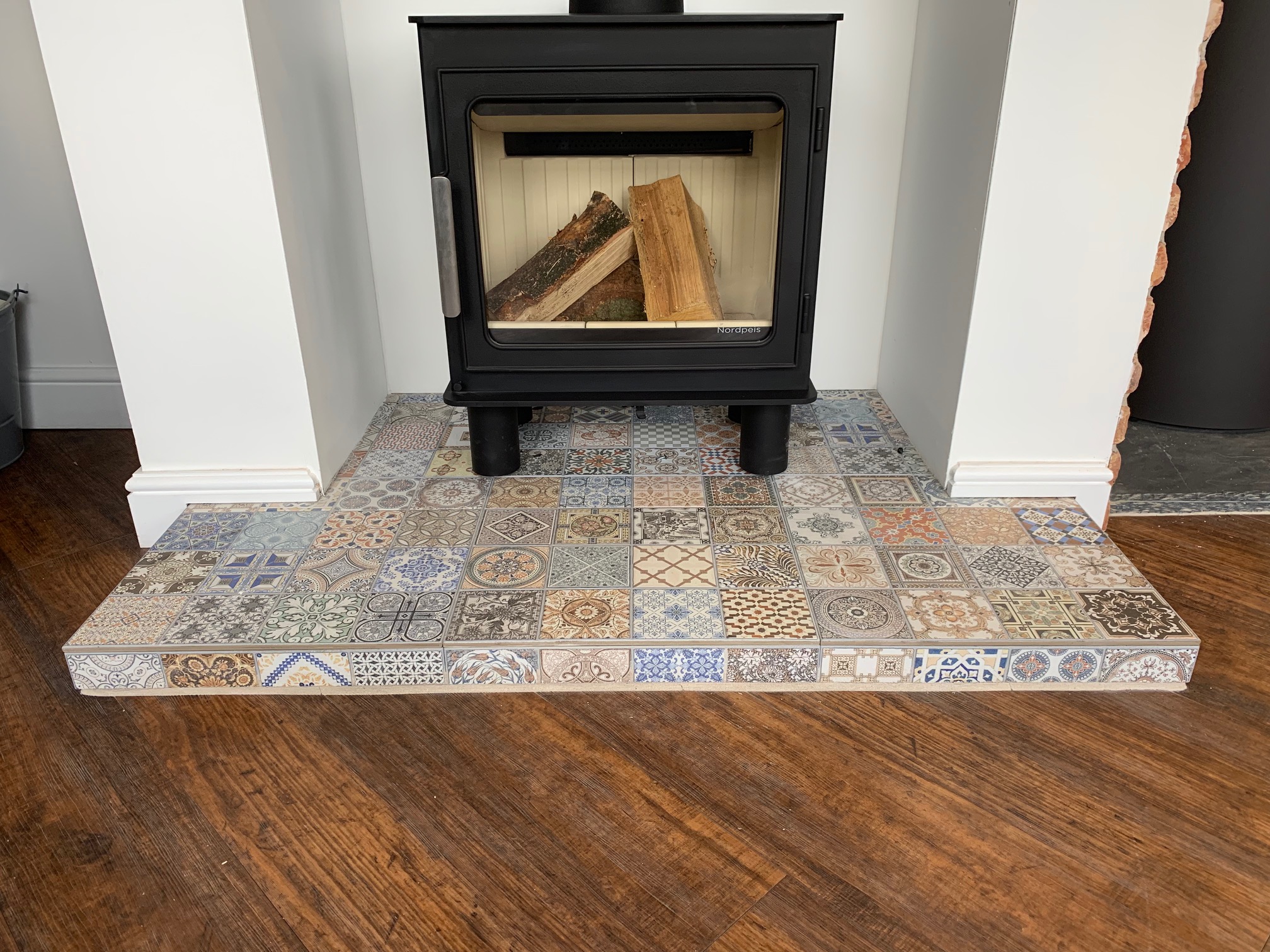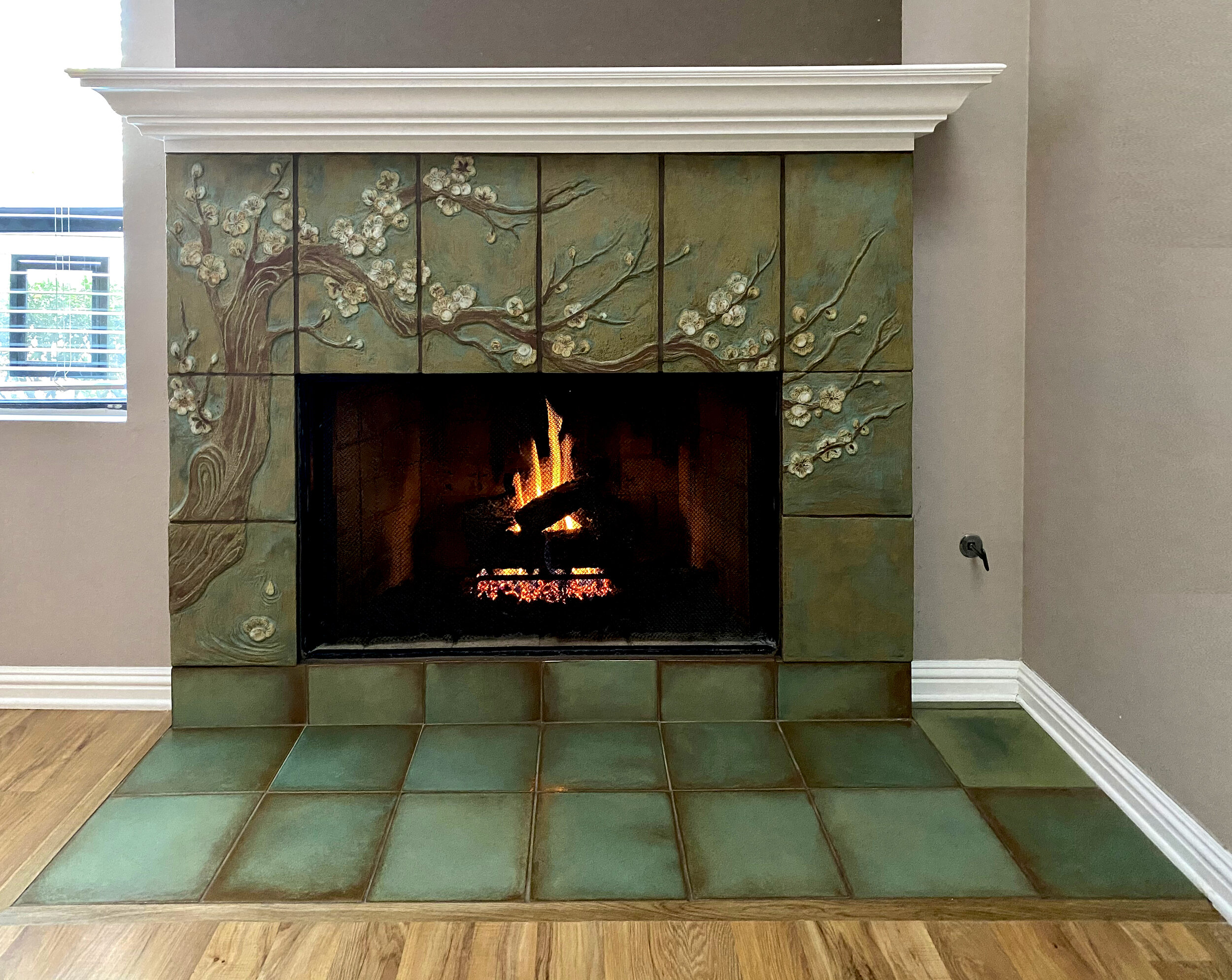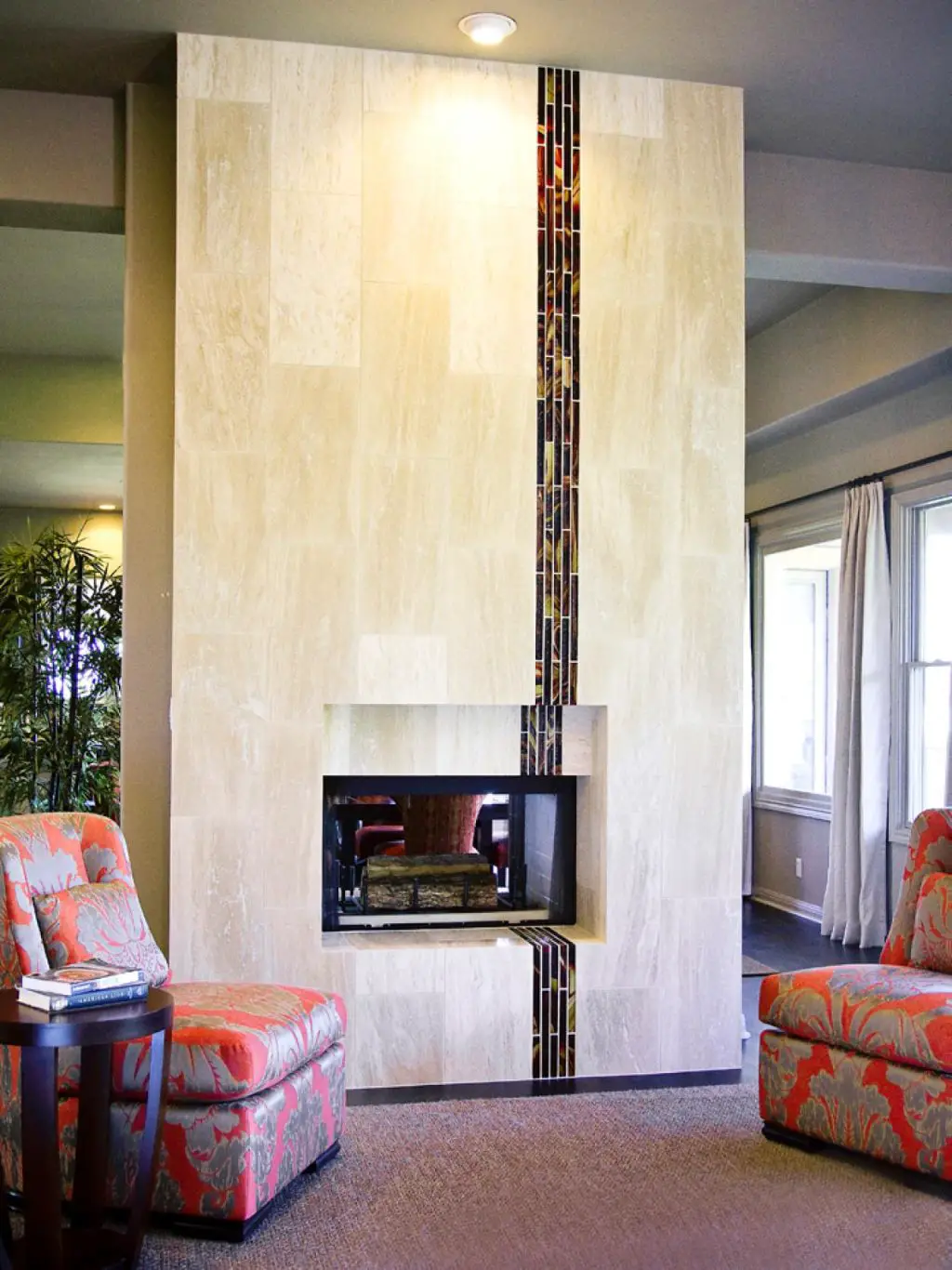Fireplaces serve as a central feature in many homes, providing warmth, ambiance, and a focal point for interior design. The choice of tiles for a fireplace surround plays a crucial role in both the aesthetic and functional aspects of the fireplace. Selecting the right tiles can enhance the beauty of your fireplace while ensuring safety and durability. Today we will discuss different types of tiles suitable for fireplaces, their benefits, installation process, maintenance, design considerations, and more. Additionally, we will discuss common mistakes to avoid and answer frequently asked questions about fireplace tiles.

Types of Tiles Suitable for Fireplaces
Ceramic Tiles
Ceramic tiles are a popular choice for fireplace surrounds due to their versatility, durability, and affordability. Made from clay and other natural materials, ceramic tiles are glazed and fired at high temperatures, making them heat-resistant and suitable for use around fireplaces. They come in a wide range of colors, patterns, and finishes, allowing for creative and personalized designs.
Porcelain Tiles
Porcelain tiles are a type of ceramic tile that is denser, harder, and more water-resistant. They are made from finer clay and fired at higher temperatures, resulting in a durable and non-porous surface. Porcelain tiles are highly resistant to heat and stains, making them an excellent choice for fireplace surrounds. They are available in various styles, including wood-look and stone-look finishes.
Natural Stone Tiles
Natural stone tiles, such as marble, granite, slate, and travertine, are prized for their natural beauty and unique textures. Each stone tile is unique, offering a one-of-a-kind look for your fireplace surround. Natural stone tiles are heat-resistant and durable, but they may require sealing to protect against stains and moisture. Their luxurious appearance makes them a popular choice for high-end fireplace designs.

Glass Tiles
Glass tiles add a modern and sophisticated touch to fireplace surrounds. They are made from tempered glass, which is heat-resistant and durable. Glass tiles reflect light, creating a bright and shimmering effect that enhances the visual appeal of the fireplace. They are available in various colors, sizes, and finishes, including frosted, clear, and iridescent options.
Metal Tiles
Metal tiles offer a sleek and contemporary look for fireplace surrounds. Made from materials such as stainless steel, copper, and aluminum, metal tiles are heat-resistant and durable. They can be used to create a striking and industrial aesthetic, and they are available in various finishes, including brushed, polished, and matte. Metal tiles are also easy to clean and maintain.
Mosaic Tiles
Mosaic tiles consist of small pieces of ceramic, porcelain, glass, or stone arranged in intricate patterns. They offer endless design possibilities and can be used to create detailed and artistic fireplace surrounds. Mosaic tiles are heat-resistant and durable, making them suitable for use around fireplaces. They can add a unique and personalized touch to any fireplace design.

Benefits of Using Tiles for Fireplaces
Aesthetic Appeal
One of the primary benefits of using tiles for fireplace surrounds is their aesthetic appeal. Tiles come in a wide range of colors, patterns, and finishes, allowing homeowners to create a customized and visually stunning design. Whether you prefer a classic, modern, or eclectic look, there are tiles to suit every style and taste.
Durability and Longevity
Tiles are known for their durability and longevity, making them an excellent choice for fireplace surrounds. High-quality tiles, such as porcelain and natural stone, can withstand the high temperatures generated by a fireplace without cracking or discoloring. With proper installation and maintenance, tiled fireplace surrounds can last for many years.
Heat Resistance
Tiles are inherently heat-resistant, making them a safe and practical option for fireplace surrounds. Materials such as ceramic, porcelain, glass, and metal are specifically designed to withstand high temperatures, ensuring that the tiles will not be damaged by the heat from the fireplace. This heat resistance also helps protect the surrounding walls and surfaces.

Easy Maintenance
Tiles are relatively easy to clean and maintain, requiring minimal effort to keep them looking their best. Most tiles can be cleaned with a damp cloth and mild detergent, making them a practical choice for busy households. Additionally, tiles are resistant to stains and moisture, which helps maintain their appearance over time.
Versatility in Design
The versatility of tiles allows for endless design possibilities. Tiles can be arranged in various patterns, such as herringbone, chevron, or mosaic, to create unique and personalized fireplace surrounds. They can also be mixed and matched to combine different colors, textures, and finishes, providing endless opportunities for creativity and customization.
Increased Home Value
Investing in a beautifully tiled fireplace surround can increase the value of your home. A well-designed and stylish fireplace can be a significant selling point for potential buyers, adding to the overall appeal and marketability of the property. High-quality tiles, such as natural stone or designer ceramics, can enhance the perceived value of the home.

Interesting Articles You May Want to Check:
- Fireplace Tile Ideas Craftsman
- Brown Fireplace Tiles
- How to Tile a Fireplace with Stone
- Fireclay Tile Fireplace
- Fireplace Tile Sets

Installation Process of Fireplace Tiles
Pre-Installation Preparation
Before installing tiles on a fireplace surround, it is essential to prepare the area properly. This involves cleaning the surface, removing any existing finishes, and ensuring that the substrate is sound and level. Proper preparation is crucial for achieving a successful and long-lasting tile installation.
Choosing the Right Adhesive
Selecting the right adhesive is critical for the proper installation of fireplace tiles. Heat-resistant adhesive, such as thin-set mortar or epoxy, is recommended for securing tiles around a fireplace. These adhesives are designed to withstand high temperatures and provide a strong bond between the tiles and the substrate.
Measuring and Cutting Tiles
Accurate measurement and cutting of tiles are essential for achieving a professional-looking installation. Measure the area to be tiled and mark the tiles accordingly. Use a tile cutter or wet saw to cut the tiles to the required size and shape. Precision in measuring and cutting ensures a seamless and aesthetically pleasing result.

Laying the Tiles
Begin laying the tiles from the bottom of the fireplace surround, working your way up. Apply the adhesive to a small section of the substrate and press the tiles firmly into place, using tile spacers to maintain even spacing between the tiles. Continue this process until the entire area is covered, making any necessary adjustments as you go.
Grouting the Tiles
Once the tiles are in place and the adhesive has set, it is time to apply the grout. Choose a grout that is suitable for high-temperature environments and matches the color of the tiles. Apply the grout using a rubber float, pressing it into the gaps between the tiles. Wipe away any excess grout with a damp sponge and allow it to cure according to the manufacturer’s instructions.
Sealing the Tiles
Sealing the tiles is an important step in the installation process, especially for natural stone tiles. A high-quality sealant helps protect the tiles from stains, moisture, and heat damage. Apply the sealant according to the manufacturer’s instructions, ensuring that the entire surface is covered. Reapply the sealant periodically to maintain its effectiveness.

Maintenance of Fireplace Tiles
Regular Cleaning
Regular cleaning is essential to keep fireplace tiles looking their best. Use a soft cloth or sponge and a mild detergent to clean the tiles, avoiding abrasive cleaners that can scratch the surface. For natural stone tiles, use a pH-neutral cleaner specifically designed for stone surfaces. Regular cleaning helps prevent the buildup of soot, dust, and grime.
Inspecting for Damage
Periodically inspect the fireplace tiles for any signs of damage, such as cracks, chips, or discoloration. Addressing these issues promptly can prevent further damage and maintain the integrity of the tile installation. Small cracks or chips can often be repaired with tile filler or epoxy, while more extensive damage may require professional assistance.
Reapplying Sealant
For natural stone tiles, reapplying sealant is an important part of maintenance. The sealant helps protect the tiles from stains and moisture, preserving their appearance and durability. Follow the manufacturer’s recommendations for reapplying sealant, typically every 1-2 years. Clean the tiles thoroughly before applying the sealant to ensure proper adhesion.

Grout Maintenance
Maintaining the grout between the tiles is crucial for the overall appearance and functionality of the fireplace surround. Over time, grout can become discolored or damaged. Clean the grout regularly with a grout cleaner and a soft brush. If the grout shows signs of wear or damage, consider regrouting the affected areas to restore its appearance and integrity.
Preventing Soot Buildup
To prevent soot buildup on fireplace tiles, ensure that the fireplace is functioning properly and that the flue is open when the fireplace is in use. Regularly clean the fireplace and remove any ash or debris that can contribute to soot buildup. Using a fireplace screen can also help reduce the amount of soot that settles on the tiles.
Professional Maintenance
For extensive maintenance or repairs, consider hiring a professional tile installer or stone restoration specialist. Professionals have the expertise and tools needed to address complex issues and ensure that your fireplace tiles remain in excellent condition. Regular professional maintenance can help extend the life of your tile installation.

Design Considerations for Fireplace Tiles
Matching Interior Decor
When selecting tiles for a fireplace surround, it is important to consider how they will integrate with the existing interior decor. Choose tiles that complement the colors, textures, and overall style of the room. A well-matched fireplace surround can enhance the aesthetic appeal and create a cohesive look.
Creating a Focal Point
A tiled fireplace surround can serve as a stunning focal point in any room. Consider how the tiles will draw attention and create a sense of balance in the space. Position furniture and decor to highlight the fireplace and make it the centerpiece of the room.
Incorporating Patterns and Textures
Incorporating patterns and textures into the tile design can add visual interest and depth to the fireplace surround. Consider using patterned tiles, mosaic tiles, or tiles with textured surfaces to create a unique and personalized design. Mixing different tile styles can also add complexity and charm to the fireplace.
Considering Scale and Proportion
Ensure that the size and proportion of the tiles are appropriate for the fireplace and the surrounding area. Large tiles can create a dramatic and modern look, while smaller tiles can add detail and intricacy. Consider the scale of the room and the fireplace when choosing tile sizes to achieve a balanced and harmonious design.
Exploring Color Options
Tiles are available in a wide range of colors, allowing for creative and personalized designs. Consider the color scheme of the room and choose tiles that complement or contrast with the existing colors. Neutral tones can create a timeless and elegant look, while bold colors can make a striking statement.
Customization and Personalization
Many manufacturers offer customization options for fireplace tiles, allowing you to choose specific finishes, patterns, and designs that suit your taste and decor. Customization can ensure that your fireplace surround is a perfect fit for your home, reflecting your unique style and preferences.

Common Mistakes to Avoid with Fireplace Tiles
Using Non-Heat-Resistant Tiles
One of the most common mistakes is using tiles that are not heat-resistant. Not all tiles are suitable for use around fireplaces, and using non-heat-resistant tiles can result in cracking, discoloration, and damage. Always choose tiles that are specifically designed for high-temperature environments.
Improper Adhesive Selection
Selecting the wrong adhesive can compromise the installation of fireplace tiles. It is essential to use a heat-resistant adhesive that can withstand the temperatures generated by the fireplace. Using standard tile adhesive can result in tiles loosening or falling off over time.
Inaccurate Measurements
Failing to take accurate measurements can lead to tiles that do not fit properly, resulting in gaps and an uneven appearance. Always measure the area to be tiled carefully and double-check your dimensions before cutting and installing the tiles. Precision in measurement ensures a professional-looking result.
Skipping Surface Preparation
Skipping surface preparation can lead to poor adhesion and an unstable tile installation. Ensure that the substrate is clean, level, and free of any existing finishes before applying adhesive and tiles. Proper surface preparation is crucial for achieving a durable and long-lasting installation.
Neglecting Grout and Sealant Maintenance
Neglecting to maintain grout and sealant can result in discoloration, damage, and reduced durability of the tiles. Regularly clean the grout and reapply sealant as needed to protect the tiles from stains and moisture. Proper maintenance helps preserve the appearance and longevity of the tile installation.
Overlooking Professional Assistance
While DIY tile installation can be rewarding, overlooking the need for professional assistance can lead to mistakes and subpar results. If you are unsure about any aspect of the installation process, consider hiring a professional tile installer. Professionals have the expertise and tools needed to ensure a successful and flawless installation.

What are the best types of tiles for fireplace surrounds?
The best types of tiles for fireplace surrounds include ceramic, porcelain, natural stone, glass, metal, and mosaic tiles. Each type has its own benefits and aesthetic appeal, making it important to choose based on your specific needs and design preferences. Ceramic and porcelain tiles are popular for their durability and heat resistance, while natural stone tiles offer unique textures and a luxurious look.
How do I choose the right adhesive for fireplace tiles?
Choosing the right adhesive for fireplace tiles is crucial for a secure and durable installation. Use a heat-resistant adhesive, such as thin-set mortar or epoxy, which can withstand the high temperatures generated by the fireplace. Ensure that the adhesive is suitable for the specific type of tile you are using, and follow the manufacturer’s recommendations for application.
Can I install fireplace tiles myself, or should I hire a professional?
While it is possible to install fireplace tiles yourself, hiring a professional can ensure the best results. Professional tile installers have the experience and tools needed to achieve a flawless installation. If you choose to install the tiles yourself, carefully follow the manufacturer’s instructions and take your time with each step to ensure accuracy and precision.
How do I maintain and clean fireplace tiles?
Maintaining and cleaning fireplace tiles involves regular cleaning with a soft cloth or sponge and a mild detergent. For natural stone tiles, use a pH-neutral cleaner specifically designed for stone surfaces. Periodically inspect the tiles for any signs of damage and reapply sealant as needed to protect against stains and moisture. Regular grout maintenance is also important to keep the installation looking its best.
Are there any special considerations for using natural stone tiles on a fireplace?
Natural stone tiles, such as marble, granite, slate, and travertine, require special considerations for use on a fireplace. These tiles may need to be sealed to protect against stains and moisture. Natural stone is also more susceptible to damage from heat and requires regular maintenance to preserve its appearance. When using natural stone tiles, ensure that they are suitable for high-temperature environments and follow proper installation and maintenance practices.
What should I do if my fireplace tiles get damaged?
If your fireplace tiles sustain damage, it is important to address the issue promptly. Small cracks or chips can often be repaired with tile filler or epoxy. For more extensive damage, consider replacing the affected tiles or consulting a professional for repair or replacement. Regular maintenance and careful handling can help prevent damage and extend the life of your fireplace tiles.

Related Posts: